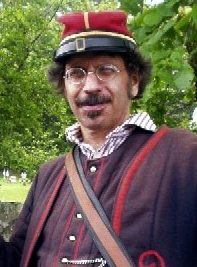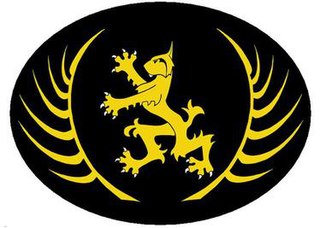
A longsword is a type of European sword characterized as having a cruciform hilt with a grip for primarily two-handed use, a straight double-edged blade of around 85 to 110 cm, and weighing approximately 1 to 1.5 kg.

Royal Armouries Ms. I.33 is the earliest known surviving European fechtbuch, and one of the oldest surviving martial arts manuals dealing with armed combat worldwide. I.33 is also known as the Walpurgis manuscript, after a figure named Walpurgis shown in the last sequence of the manuscript, and "the Tower manuscript" because it was kept in the Tower of London during 1950-1996; also referred to as British Museum No. 14 E iii, No. 20, D. vi.

Swordsmanship or sword fighting refers to the skills and techniques used in combat and training with any type of sword. The term is modern, and as such was mainly used to refer to smallsword fencing, but by extension it can also be applied to any martial art involving the use of a sword. The formation of the English word "swordsman" is parallel to the Latin word gladiator, a term for the professional fighters who fought against each other and a variety of other foes for the entertainment of spectators in the Roman Empire. The word gladiator itself comes from the Latin word gladius, which is a type of sword.
Johannes Liechtenauer was a German fencing master who had a great level of influence on the German fencing tradition in the 14th century.

Historical European martial arts (HEMA) are martial arts of European origin, particularly using arts formerly practised, but having since died out or evolved into very different forms.

The German school of fencing is a system of combat taught in the Holy Roman Empire during the Late Medieval, Renaissance, and Early Modern periods, as described in the contemporary Fechtbücher written at the time. The geographical center of this tradition was in what is now Southern Germany. During the period in which it was taught, it was known as the Kunst des Fechtens, or the "Art of Fencing". Though the German school of fencing focuses primarily on the use of the two-handed longsword, it also describes the use of many other weapons, including polearms, daggers, messers, and the staff, as well as describing mounted combat and unarmed grappling.

In martial arts, a waster is a practice weapon, usually a sword, and usually made out of wood, though nylon (plastic) wasters are also available. Nylon being much safer than wood, due to it having an adequate amount of flex for thrusts to be generally safe, unlike wooden wasters. Even a steel feder has more flex than most wooden wasters. The use of wood or nylon instead of metal provides an economic option for initial weapons training and sparring, at some loss of genuine experience. A weighted waster may be used for a sort of strength training, theoretically making the movements of using an actual sword comparatively easier and quicker, though modern sports science shows that an athlete would most optimally train with an implement which is closest to the same weight, balance, and shape of the tool they will be using. Wasters as wooden practice weapons have been found in a variety of cultures over a number of centuries, including ancient China, Ireland, Iran, Scotland, Rome, Egypt, medieval and renaissance Europe, Japan, and into the modern era in Europe and the United States. Over the course of time, wasters took a variety of forms not necessarily influenced by chronological succession, ranging from simple sticks to clip-point dowels with leather basket hilts to careful replicas of real swords.

Ringen is the German language term for grappling (wrestling). In the context of the German school of historical European martial arts during the Late Middle Ages and the German Renaissance, Ringen refers to unarmed combat in general, including grappling techniques used as part of swordsmanship.

The term Italian school of swordsmanship is used to describe the Italian style of fencing and edged-weapon combat from the time of the first extant Italian swordsmanship treatise (1409) to the days of Classical Fencing.

Joachim Meyer was a self described Freifechter living in the then Free Imperial City of Strasbourg in the 16th century and the author of a fechtbuch Gründtliche Beschreibung der Kunst des Fechtens first published in 1570.
Association for Renaissance Martial Arts (ARMA) is a US-based non-profit organization dedicated to the study and practice of historical European martial arts of the 15th to 17th centuries.

Patri J. Pugliese was a historian of science, dance, and fencing, as well as a teacher of historical dance.
The Chicago Swordplay Guild is a modern school of swordsmanship and Western martial arts, and non-profit organization based in Chicago, Illinois, United States. It provides organized instruction in the study and practice of historical European swordplay, with a principal focus on the Italian school of swordsmanship and other martial arts of the 14th–17th centuries. Co-founded in 1999 by Gregory Mele and Mark Rector, the Chicago Swordplay Guild seeks to be consistent with the methodology of the ancient European fencing schools by combining scholarship and research into the teachings of the historical Masters, with the practical knowledge gained through solo and partnered drilling and fencing. Since techniques are taught in reference to how effective they would be in a real encounter, the Guild practices with an absolute emphasis on safety, control, competence, and skill at arms.
Brian R. Price is an American university professor, author, editor, publisher, martial arts instructor of the Italian school of swordsmanship, reconstructive armorer, and member of the Society for Creative Anachronism. He is Associate Professor of History at Hawai'i Pacific University, where he offers courses in the history of warfare, in counterinsurgency, and in strategy at the graduate and undergraduate levels. He speaks regularly at conferences both for his current field on counterinsurgency and in his earlier, and now secondary field, on chivalric topics. His page at https://hpu.academia.edu/BrianRPrice lists his current and recent research projects. He began his studies of medieval history in 1990, but began to shift his interests as the Afghan and Iraq wars progressed, increasingly emphasizing aspects of modern military theory, especially ways through which culture, doctrine and military practice interweave. These modern topics have been a prominent part of his work since his graduation from the University of North Texas and deployment to Afghanistan as part of the Human Terrain System in 2011-2012. He has spoken at the UK Ministry of Defence, at the Society for Military History, the World History Conference, several academic martial arts symposia, and appeared on television to discuss the situation in Ukraine.
Nova Scrimia is an Italian organisation which promotes the teaching of the Italian school of swordsmanship, of stick fencing, of short range fencing (dagger) and of unarmed fencing from the documented period that goes from the 15th century to the 20th century. Nova Scrimia is currently represented in Italy and other European countries, in USA and in Mexico.
Italian martial arts include all those unarmed and armed fighting arts popular in Italy between the Bronze age until the 19th century AD. It involved the usage of weapons. Each weapon is the product of a specific historical era. The swords used in Italian martial arts range from the Bronze daggers of the Nuragic times to the gladius of the Roman legionaries to swords which were developed during the renaissance, the baroque era and later. Short blades range from medieval daggers to the liccasapuni Sicilian duelling knife.

Schola Gladiatoria (SG) is a historical European martial arts (HEMA) group based in Ealing, west London, Great Britain, founded in 2001 and led by Matt Easton. It provides organized instruction in the serious study and practice of historical European swordplay. Schola seeks to be consistent with the methodology of the ancient European fencing schools by combining scholarship and research into the teachings of the historical masters, with the practical knowledge gained through solo and partnered drilling, and free play (sparring).

Ars Ensis is the largest Hungarian HEMA association. It is a non-profit martial arts organization whose members research and teach mainly medieval and Renaissance historical European martial arts, based on period sources. The instructors of AE have been working on creating this HEMA community since 2003, and Ars Ensis has been operating as a Hungarian incorporated association since 2010.

The Renaissance Sword Club is a historical European martial arts group based in London, South East of England and Brittany, France. It was founded in 2013 by Rob Runacres. Its primary aim is the research and recreation of European swordsmanship of the sixteenth and seventeenth centuries, specifically those concerned with the rapier and spada da lato, as well as their companion weapons such as the dagger, cloak, buckler and rotella. Members have also pursued interests outside of the core curriculum in to staff weapons, longsword and small sword.
The practice of Historical European Martial Arts (HEMA) first started in Australia in the late 19th century before largely dying out. There was then a revival of interest in the late 20th century to the current day. The practice of HEMA in Australia has grown to be a popular activity, with clubs all in capital cities, and the larger cities in Australia, Sydney and Melbourne, each have a number of clubs teaching various styles.













